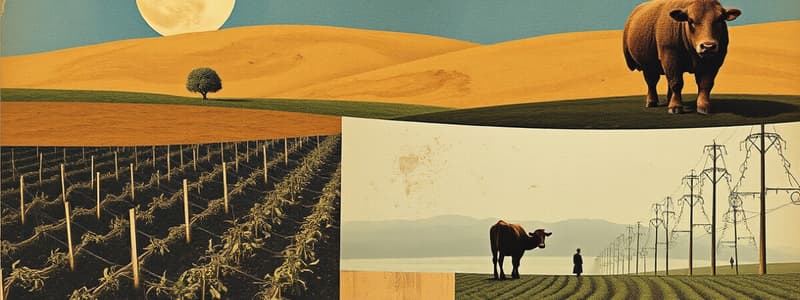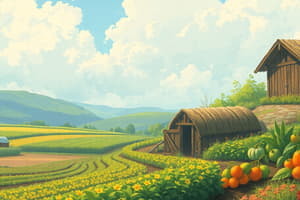Podcast
Questions and Answers
How does diversification of genetic resources contribute to farming resilience?
How does diversification of genetic resources contribute to farming resilience?
It enhances the ability to cope with disturbances by providing a variety of crops that can thrive under different conditions.
What are the productivity advantages of poly-cultures over monocultures?
What are the productivity advantages of poly-cultures over monocultures?
Poly-cultures are more productive because they utilize resources more efficiently and reduce losses from pests and diseases.
In what ways do traditional multiple cropping systems contribute to global food supply?
In what ways do traditional multiple cropping systems contribute to global food supply?
They provide 20 to 40 percent of the world's food supply by ensuring diverse food sources and stable production.
Explain the role of farm biodiversity in coping with climate disasters.
Explain the role of farm biodiversity in coping with climate disasters.
What farming techniques do GIAHS farmers use to minimize crop failures?
What farming techniques do GIAHS farmers use to minimize crop failures?
How does spatial and temporal diversity of crops benefit agro-ecosystems?
How does spatial and temporal diversity of crops benefit agro-ecosystems?
What is the impact of insect and disease pressure in large farms compared to small farms?
What is the impact of insect and disease pressure in large farms compared to small farms?
Why is incorporating wild and local varieties important in farming systems?
Why is incorporating wild and local varieties important in farming systems?
What were the primary crops cultivated by the Early Harappan communities around 3000 BCE?
What were the primary crops cultivated by the Early Harappan communities around 3000 BCE?
How did the geographical location of Mohenjo-Daro contribute to its significance?
How did the geographical location of Mohenjo-Daro contribute to its significance?
Which sites are identified as urban centers during the late Harappan period?
Which sites are identified as urban centers during the late Harappan period?
What types of domestic animals were known to be present in the Harappan civilization?
What types of domestic animals were known to be present in the Harappan civilization?
What evidence suggests that millet was cultivated in the Indus Valley?
What evidence suggests that millet was cultivated in the Indus Valley?
List two legumes mentioned in the agricultural practices of the Early Harappan period.
List two legumes mentioned in the agricultural practices of the Early Harappan period.
Which fibrous plant crop was grown in both Mohenjo-Daro and Harappa?
Which fibrous plant crop was grown in both Mohenjo-Daro and Harappa?
What role did fruit crops play in the diet of the Harappan people?
What role did fruit crops play in the diet of the Harappan people?
How did the arrival of rain impact agricultural practices related to the Indus Civilization?
How did the arrival of rain impact agricultural practices related to the Indus Civilization?
What celestial bodies were significant for the Indus people in predicting rain and agricultural cycles?
What celestial bodies were significant for the Indus people in predicting rain and agricultural cycles?
Describe the function of the compass-like object found in Mohenjo-Daro and Lothal.
Describe the function of the compass-like object found in Mohenjo-Daro and Lothal.
What role did the state treasury play in the agricultural system of the Indus Civilization?
What role did the state treasury play in the agricultural system of the Indus Civilization?
How did trade evolve during the chalcolithic period according to the content?
How did trade evolve during the chalcolithic period according to the content?
What evidence suggests that the Indus people linked celestial events with agricultural timing?
What evidence suggests that the Indus people linked celestial events with agricultural timing?
What types of crops were primarily cultivated by the Indus people aside from fish-crops, according to the text?
What types of crops were primarily cultivated by the Indus people aside from fish-crops, according to the text?
In what way did the seal representations serve a purpose for the Indus civilization?
In what way did the seal representations serve a purpose for the Indus civilization?
What role did the Rigveda play in documenting India's maritime trade during the Vedic period?
What role did the Rigveda play in documenting India's maritime trade during the Vedic period?
Summarize the evidence of trade between India and China in the 12th century B.C. as per the Chinese legend.
Summarize the evidence of trade between India and China in the 12th century B.C. as per the Chinese legend.
Discuss the significance of cow as currency during the Vedic period.
Discuss the significance of cow as currency during the Vedic period.
What irrigation techniques were utilized in the Indian sub-continent during the Vedic period?
What irrigation techniques were utilized in the Indian sub-continent during the Vedic period?
Identify the types of farm implements mentioned in Vedic texts.
Identify the types of farm implements mentioned in Vedic texts.
What characterized the market activities during the Vedic age?
What characterized the market activities during the Vedic age?
Describe the condition of farm laborers during the Vedic age.
Describe the condition of farm laborers during the Vedic age.
Explain the impact of the emergence of Sramanic traditions on agriculture during the early historic period.
Explain the impact of the emergence of Sramanic traditions on agriculture during the early historic period.
What are the two types of wells mentioned in historical irrigation techniques?
What are the two types of wells mentioned in historical irrigation techniques?
Identify the water-lifting devices used in ancient irrigation as described.
Identify the water-lifting devices used in ancient irrigation as described.
What method did ancient civilizations use to keep canals full of water aside from hand methods?
What method did ancient civilizations use to keep canals full of water aside from hand methods?
What were the Sakas associated with in terms of ancient irrigation technology?
What were the Sakas associated with in terms of ancient irrigation technology?
Which natural phenomena were cited as causes of crop damage in ancient texts?
Which natural phenomena were cited as causes of crop damage in ancient texts?
List two types of pests that ancient farmers needed to protect their crops from.
List two types of pests that ancient farmers needed to protect their crops from.
What innovative system was mentioned that involved the use of oxen in irrigation?
What innovative system was mentioned that involved the use of oxen in irrigation?
What crop protection measures were historically recognized in India?
What crop protection measures were historically recognized in India?
Flashcards are hidden until you start studying
Study Notes
Agricultural Resilience and Biodiversity
- Diversification of genetic resources, production systems, and income sources enhances resilience in agriculture.
- Small farms utilizing polycultures (growing multiple crops) are more productive overall compared to large monocultures.
- Polycultures reduce losses from weeds, pests, and diseases while optimizing resource use (water, light, nutrients).
- Traditional multiple cropping systems contribute approximately 20-40% of global food supply.
- Farming systems displaying resiliency can adapt to human and climate changes, reducing crop failure risks through various techniques.
Farming Techniques and Climate Adaptation
- GIAHS farmers employ drought-resistant local varieties, water harvesting, mixed cropping, and agroforestry to minimize climate change impacts.
- Observations show that higher farm biodiversity correlates with greater resilience to climate disasters.
- Indigenous practices include using wild and local crop varieties and enhancing crop diversity both temporally and spatially.
Indus Valley Civilization
- The civilization was characterized by diverse racial interactions and effective communication through land and waterways.
- Mohenjo-Daro served as a central hub for trade and cultural exchange within Asia.
- Agricultural practices included the domestication of crops (peas, sesame, dates, cotton) and animals (water buffalo).
- By 3000 BCE, urban centers emerged, with six Harappan cities identified, including Harappa and Mohenjo-Daro.
Early Harappan Crop Cultivation
- Key crops cultivated included:
- Cereals: Wheat (Triticum species), barley (Hordeum varieties), and millet (Sorghum).
- Legumes: Field peas (Pisum arvense).
- Oilseeds: Sesame (Sesamum indicum) and mustard (Brassica juncea).
- Fibrous plants: Cotton.
- Fruit crops: Melons, date palms, and representations of banana and pomegranate.
- Spices: Fenugreek.
Agricultural Practices and Environmental Indicators
- Periodic rains were vital for agricultural sustainability, preventing floods and aiding crop growth.
- Celestial events (Mrgasira, Krittika constellations) were studied for rain predictions.
- Ancient tools, possibly for measuring agricultural timing, were discovered in Mohenjo-Daro.
Taxation and Trade Systems
- A form of agricultural tax was presumed to fund temples and state granaries.
- Trade flourished during the chalcolithic period, with records of commerce in the Rigveda.
- Evidence of maritime trade with China, including imports of sugar and silk, during the 12th century BCE.
- Local trade was documented in the Vedic age with barter systems and references to market activities.
Vedic Period Agriculture Overview
- Crop management and cultivation practices evolved during the Vedic period, highlighting agricultural diversity.
Water Management and Irrigation
- Advanced irrigation techniques included both ring wells and soak wells, with references in ancient texts.
- Canal irrigation systems allowed water transport through animal power and mechanical devices.
- Innovations in water lifting and resource distribution techniques ensured effective crop irrigation.
Plant Protection Measures
- Early records indicate proactive measures against pests (insects, birds, rodents) and natural phenomena (droughts, hailstorms).
- Various diseases affecting crops prompted protective strategies, including the use of ancient texts for preventive measures.
Studying That Suits You
Use AI to generate personalized quizzes and flashcards to suit your learning preferences.




